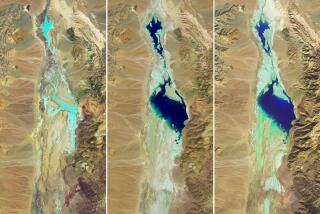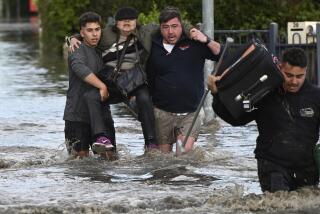Torrential Rains Make Australian Outback a ‘Garden of Eden’
WILPENA POUND, Australia — The Australian outback is normally a semi-arid scrubland stretching to the shores of a dry salt lake.
But one of the wettest spells since Europeans reached the area in the mid-19th Century has completely transformed the desert heart of the world’s driest continent.
The outback is now miles of golf course-like green merging into Lake Torrens, which is full for the first time in recorded history.
“The Big Wet has turned a dust bowl into the Garden of Eden,” said Brent Williams, wildlife ranger in Flinders Park National Park.
Foot of Rain Falls
Parched outback areas in Queensland, South Australia and the Northern Territory were deluged with a foot of rain in March, three times the annual average for the Red Center.
Creeks, dry for years on end, turned overnight into torrents hundreds of yards wide, flooding huge areas.
Much of the floodwater headed for the sprinkling of salt lakes in the northern section of South Australia and in particular Lake Eyre, which attracts water from an area roughly the combined size of France, Spain and Portugal.
Two months after the downpour, Lake Eyre, which usually is covered by a thick salt crust lying 50 feet below sea level, has become the world’s 16th biggest lake after filling for only the fourth time since white settlers first came upon it.
Birds Flock to Area
Pelicans, terns and other birds have flocked in from the coast by the thousands to breed on the lakes, which should stay full for several months, and perhaps a year or more, after further heavy rain in southern Queensland over the last month.
The rain reaps huge, sudden benefits. Last month, rangers found over 100,000 nests of the banded stilt, a wading bird thought to be extinct in South Australia, on an island in flooded Lake Torrens.
Food for the bird life is provided by fresh-water fish--bream, gudgeon and perch--that have washed down flooded rivers to the lakes, which become breeding grounds for every kind of insect life.
The water also causes extraordinary happenings further down the food chain.
The water-holding frog is awakened after spending many years cocooned in an underground cell while shrimp, crabs and plankton appear--from where remains a mystery.
Eggs Have Lain Dormant
“I suspect that most of the salt-tolerant creatures are products of eggs lying dormant in the mud for perhaps decades,” said Gordon Stanger, lecturer in earth sciences at Adelaide’s Flinders University, after studying Lake Torrens.
Bushes, grasses and trees are showing luxuriant growth, while flowers, normally dormant as the winter season approaches, are growing at breakneck speed in an attempt to complete their life cycle before dry conditions return.
Farmers, hit by several years of drought conditions, have also profited from the downpour.
“Paddocks have been opened up, distress sales are no longer necessary and farmers can afford to fatten up stock,” said accountant Phil Camens in Alice Springs. “They are pretty happy, and it looks like I’m going to be busy over the next months.”
The sudden fall in cattle sales led to record auction prices in the Darling Downs area of southern Queensland as exporters found it hard to fulfill contracts.
Some Problems, Too
However, the rain has also brought its share of problems for farmers.
The floods washed away much precious topsoil and destroyed sections of a 6,040-mile fence--the longest man-made object in the world--erected to control the country’s wild dingo dogs.
Heavy sheep losses from dingo attacks have been reported in outback areas recently, and more than 120 of the wild dogs are reported to be roaming inside the fence in South Australia.
Darling Downs, the nation’s breadbasket, is suffering from a plague of mice, with about 30% of summer grain crops in the area estimated to have been eaten by the rodents.
To beat the mice, farmers are harvesting grain prematurely and drying it by machine, an extremely costly exercise.
“If the plague is not curtailed by the end of next month, we can expect extreme danger,” one farmer said. “The other day, three kids at my neighbor’s place killed 750 mice in 30 minutes.”
More to Read
Sign up for Essential California
The most important California stories and recommendations in your inbox every morning.
You may occasionally receive promotional content from the Los Angeles Times.









